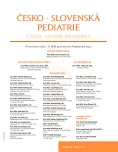Allergy to beta-lactam antibiotics in children
Authors:
J. Paukert; E. Kopelentová; L. Dvořáková; M. Králová; M. Charvátová; M. Paukertová; Š. Dobiášová
Authors‘ workplace:
Ambulance alergologie a klinické imunologie, Dětské oddělení, Oblastní nemocnice Kolín, a. s.
primář MUDr. R. Hrdlička
Published in:
Čes-slov Pediat 2015; 70 (1): 9-13.
Category:
Original Papers
Overview
Allergy to beta-lactam antibiotics is frequently reported in the medical history. Diagnosis is usually based on clinical symptoms. Evaluation by skin tests, laboratory tests and a challenge test in selected cases helps to determine the correct diagnosis of a drug allergy.
We evaluated 173 patients with suspected beta-lactam hypersensitivity between years 2008–2014. Allergy to beta-lactam antibiotics was confirmed in only 16 (10%) patients. Out of those 3 (19%) experienced anaphylaxis, 5 (31%) early skin reaction and 8 (50%) delayed skin reaction. The diagnosis was confirmed by laboratory tests in 2 cases (13%), skin testing in 6 cases (37%) and a challenge test in 8 cases (50%). After completion of allergologic evaluation the suspected antibiotic was released for further use in 90%. Drug provocation testing/challenge testing is a safe and integral part of the evaluation.
Key words:
penicillin, beta-lactam antibiotics, antibiotic allergy, provocation testing, skin testing
Sources
1. Demoly P, Adkinson NF, Brockow K, et al. International Consensus on drug allergy. Allergy 2014; 69: 420-437.
2. Torres MJ, Blanca M, Fernandez J, et al. Diagnosis of immediate allergic reactions to beta-lactam antibiotics. Allergy 2003; 58: 961–972.
3. Romano A, Blanca M, Torres MJ, et al. Diagnosis of nonimmediate reactions to beta-lactam antibiotics. Allergy 2004; 59: 1153–1160.
4. Blanca M, Romano A, Torres MJ, et al. Update on the evaluation of hypersensitivity reactions to betalactams. Allergy 2009; 64: 183–193.
5. Brockow K, Garvey LH, Aberer W, et al. Skin test concentrations for systemically administered drugs – an ENDA/EAACI Drug Allergy Interest Group position paper. Allergy 2013; 68: 702–712.
6. Ponvert C, Le Clainche L, de Blic J, et al. Allergy to β-lactam antibiotics in children. Pediatrics 1999; 104(4): e45.
7. Caubet JC, Kaiser L, Lemaitre B, et al. The role of penillin in beningn skin rashes in childhood: A prospective study based on drug rechalenge. J Allergy Clin Immunol 2011; 127: 218–222.
8. Zambonino MA, Corzo JL, Muñoz C, et al. Diagnostic evaluation of hypersenzitivity reactions to beta-lactam antibiotics in a large population of children. Pediatr Allergy Immunol 2014; 25: 80–87.
9. Romano A, Quaratino D, Papa G, et al. Aminopenicillin allergy. Arch Dis Child 1997; 76: 513–517.
10. Sade K, Holtzer I, Levo Z, et al. The economic burden of antibiotic treatment of penicillin-allergic patients in internal medicine wards of a general tertiary care hospital. Clin Exp Allergy 2003; 33: 501–506.
11. MacLauglin EJ, Saseen EJ, Malone DC. Costs of beta-lactam allergies: selection and costs of antibiotics for patients with reported beta-lactam allergy. Arch Fam Med 2000 Aug; 9 (8): 722–726.
12. Solensky R, Khan DA, et al. Drug allergy: An updated practice parameter, VII. specific drugs, A. β-lactam antibiotics, 1. penicillin. Ann Allergy Asthma Immunol 2010 Oct; 105: 273.e19.
13. Blanca-López N, Zapatero L, Alonso E, et al. Skin testing and drug provocation in the diagnosis of nonimmediate reactions to aminopenicillins in children. Allergy 2009; 64: 229–233.
14. Aberer W, Bircher A, Romano A, et al. Drug provocation testing in the diagnosis of drug hypersensitivity reactions: general considerations. Allergy 2003; 58: 854–863.
15. Trcka J, Seitz CS, Bröcker EB, et al. Aminopenicillin induced exanthema allows treatment with certain cephalosporins or phenoxymethyl penicillin. J Antimicrob Chemother 2007; 60: 107–111.
16. Demoly P, Romano A, Botelho C, et al. Determining the negative predictive value of provocation with beta-lactams. Allergy 2010; 65: 327–332.
17. Brockow K, Romano A, Blanca M, et al. General considerations for skin test procedures in the diagnosis of drug hypersensitivity. Allergy 2002; 57: 45–51.
Labels
Neonatology Paediatrics General practitioner for children and adolescentsArticle was published in
Czech-Slovak Pediatrics

2015 Issue 1
Most read in this issue
- Rhabdomyolysis after heavy physical exercise at the fithess center
- Primary Care Paediatricians (PCP) and their options in providing services to newborns, infants, children and adolescent patients
- Renal cysts and diabetes syndrome
- Malignant tumours of thyroid gland in children
